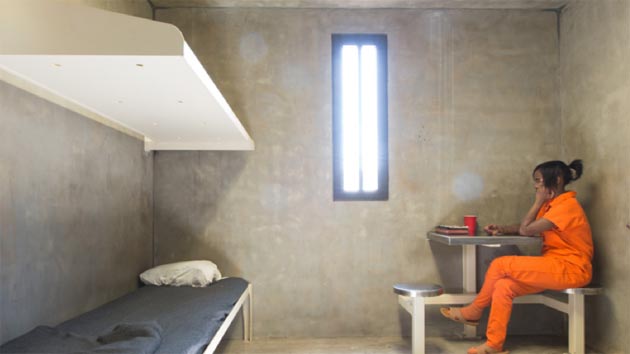
Oxford/istockphoto
Last month, 16-year-old Gynnya McMillen became part of a disturbing trend—one of a growing number of girls across the country who’ve been detained after getting charged with a misdemeanor. Then mysteriously, one day after she was booked into a Kentucky detention center, McMillen was found dead in her cell.
On the morning of January 11, an employee at the Lincoln Village Regional Juvenile Detention Center found McMillen, who was not breathing. “She is cold and stiff, there is no respiration, no vital signs,” the employee told a 911 dispatcher. About an hour later, McMillen was pronounced dead. Little is known about why McMillen wound up dead while in juvenile detention, a locked facility where young people charged with crimes are held while they wait for future court dates or other action in their cases.
The incident, and the limited information that has been released to the public about it, has sparked outrage from McMillen’s family and their supporters. State officials have launched two parallel investigations into the girl’s death, including a full autopsy. Kentucky’s Justice and Public Safety Cabinet Secretary John Tilley has asked that those investigations “be expedited,” a cabinet spokesperson told Mother Jones, adding that they “are nearing completion.” The cabinet declined to comment further about specific details in the case, citing juvenile confidentiality statutes.
Here is what we know—and don’t know—about the case so far:
McMillen was taken to Lincoln Village after the police responded to a domestic violence call. Shelbyville police officers arrived at McMillen’s mother’s house on January 10. McMillen had been living at the Maryhurst foster home in Louisville, Kentucky, and was visiting her mom for the weekend, where they got into a fight, according to BuzzFeed News. The Shelbyville police called a court-designated worker—a state official who makes legal decisions in cases involving juveniles—who then contacted a judge and requested that McMillen be detained. McMillen was charged with a misdemeanor assault and transferred to Lincoln Village, a state-run juvenile detention center in Elizabethtown. The police said McMillen’s mother suffered minor injuries. Young people under the age of 18 who are charged with low-level crimes can be held in detention centers until a court decides what further action is needed. Their detention typically lasts about three weeks but can extend for much longer, according to the Office of Juvenile Justice and Delinquency Prevention. In 2014, Kentucky enacted a law that was meant to help teens like McMillen avoid the court system altogether. Maryhurst declined to comment specifically on McMillen’s case, citing patient privacy laws.
McMillen had never been in detention before. A family member told 48 Hours’ Crimesider that McMillen’s one night at Lincoln Village was the only time she had ever been in detention. Prior to landing in the foster home, BuzzFeed News reported, McMillen lived with her father, who was awarded custody of her. But in November 2014, he died in his sleep. When McMillen spoke at his funeral, she promised to do well in school and make her father proud, a family member told BuzzFeed News.
At the detention center, multiple staff members physically restrained McMillen. Officials said McMillen repeatedly refused to remove her sweatshirt when staffers tried to search and photograph her during the booking process. “The staff performed an Aikido restraint hold to safely remove the youth’s hoodie,” a spokesperson for the Kentucky Department of Juvenile Justice said. “The purpose of having multiple staff involved in a controlled restraint is to ensure the safety of the youth and staff.” A female staff member then conducted the pat-down and removed McMillen’s hoodie. “As far as I’m concerned, that is a completely inappropriate use of a restraint,” Michele Deitch, an attorney and juvenile justice expert in Texas, told 48 Hours’ Crimesider. It is unclear if the restraint had anything to do with her eventual death, or if any other physical force was used against McMillen during her detention.
McMillen was placed in a cell by herself. The next morning, McMillen did not respond when staffers twice offered her food or later when they alerted her that her mother had called. Although McMillen did not reply to staff members for several hours, no one appears to have checked on McMillen during this time. A Kentucky Department of Juvenile Justice spokesperson said staff members generally do not enter a detainee’s cell unless there are “obvious signs of distress.” It’s unclear why McMillen was confined in isolation to begin with. It is unclear whether McMillen was merely in a cell alone or had been placed in solitary confinement. Kentucky is 1 of 10 states that either have no limit or allow for indefinite solitary confinement for juveniles as a form of punishment.
Authorities don’t know yet how she died. After a sheriff’s deputy arrived to transport McMillen to court, Lincoln Village employees entered McMillen’s cell and found that she was cold to the touch. Kentucky officials said McMillen appeared “to have passed away while sleeping.” Following the initial autopsy, the Hardin County coroner said there were no outward signs of trauma, such as visual bruising, and that it was unlikely she had a heart condition. The state’s Justice and Public Safety Cabinet has launched two investigations into the girl’s death, including a full autopsy. McMillen’s family has demanded that authorities release the surveillance footage that shows her final hours, as well as a recording of the emergency call that led to her arrest.
At least two Kentucky officials have lost their jobs in the wake of the incident, and one has resigned. One detention center staff member, Reginald Windham, was placed on leave for failing to check on McMillen’s cell every 15 minutes, as is required for detainees placed in isolation. On February 9, the governor’s office and justice cabinet announced that they’d fired Windham, following news reports about his long-standing record of “unacceptable behavior.” Personnel files provided to BuzzFeed News revealed that the Department of Juvenile Justice had disciplined or reprimanded Windham in five other incidents, including two that involved excessive use of force. In others, he was disciplined because he showed a lack of competency or professionalism. Bob D. Hayter, the head of the Department of Juvenile Justice, was dismissed from his job amid the investigation of the incident. The justice cabinet has not specified its reasons for Hayter’s dismissal. According to the Kentucky Center for Investigative Reporting, the department’s director of communications, Stacy Floden, also left her job in the wake of the state probe.
Gynnya McMillen’s arrest is part of a growing trend. The share of young girls in the juvenile justice system has been growing over the past 20 years, even as the number of arrests of young Americans has been on the decline. (My colleague Hannah Levintova recently broke down these numbers.) The percentage of girls who are arrested, detained, and end up in court increased between 1992 and 2013. Arrests of girls rose from 20 percent to 29 percent during this time, while detention of girls rose from 15 percent to 21 percent, according to the National Women’s Law Center. The trend has disproportionately affected girls of color: Black and American Indian girls were, respectively, 20 percent and 50 percent more likely to be detained than white girls. In 2013, black girls were the fastest-growing segment of the juvenile justice population.













